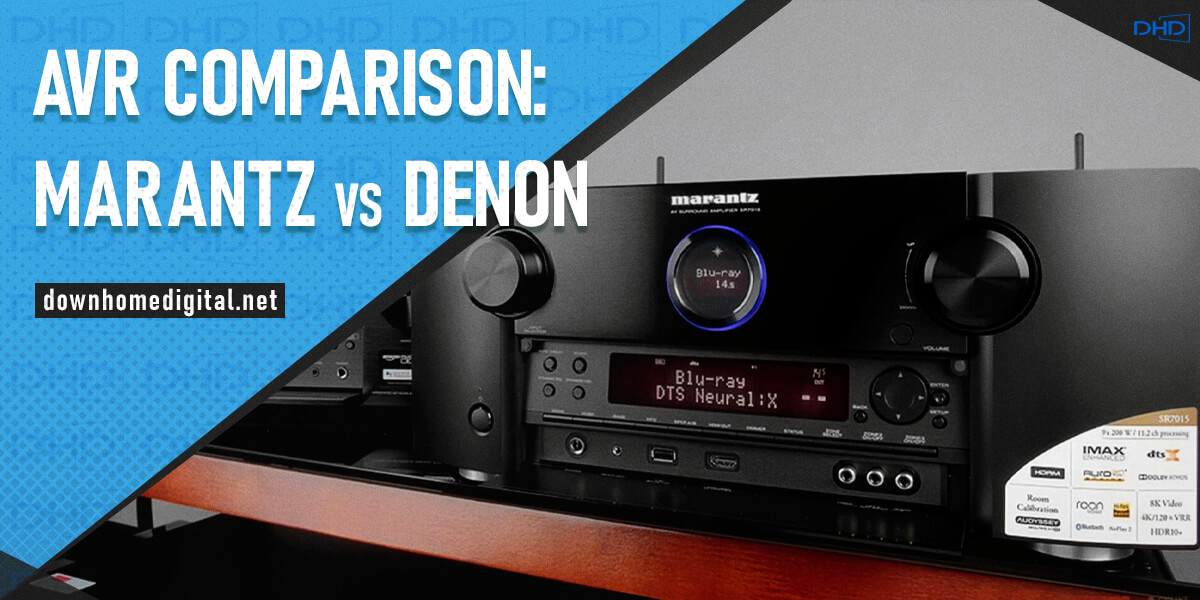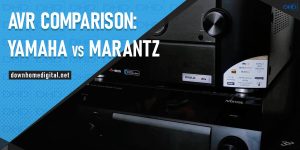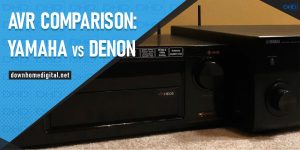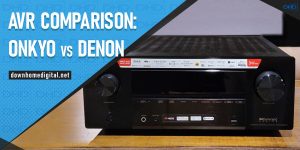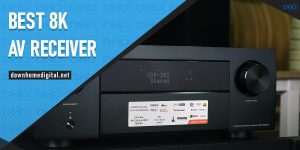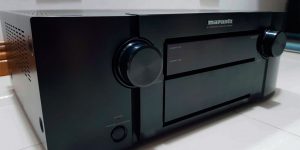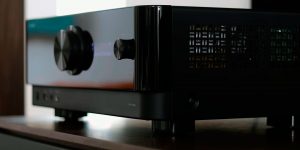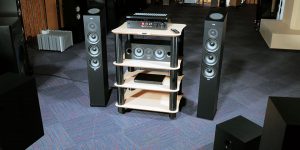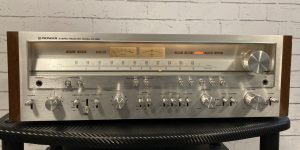Every music fan has come across a Denon and Marantz receiver at least once. These are two popular brands that are known not only to a narrow circle of professionals but also to many people who at least once thought about upgrading their home theater. And I can point out that there are some similarities and, of course, differences between them. I’ll help you understand the intricacies of Marantz vs Denon. So, I have selected the most interesting receivers of the two brands in different price segments, from entry-level to premium models, and I will compare them. From this article, you will learn the features of these models, their strengths and weaknesses, and most importantly, you will be able to determine which model is more suitable for you.
Marantz company history and overview
Marantz is an American-Japanese manufacturer specializing in Hi-Fi and home theater equipment. The company’s beginnings go back to 1951. For several decades, Marantz has been synonymous with exceptional sound quality for discerning home cineastes and sound aesthetes.
And for many years now, Marantz has been holding the bar high. Marantz receivers are renowned for their reliability, they are straightforward to connect and use, and most models offer a wide range of functions. These devices are the embodiment of the dreams of many moviegoers, both for quality and for a fair price policy.
Denon company history and overview
In the world of Hi-Fi and home theater systems, Denon is one of the largest manufacturers, and as well as Marantz is known for its high quality.
From the beginning of its history, from 1910, the company focused on audiovisual products: the first vinyl recorder, the first stereos for the Japanese market, and the first PCM recorder were some of its greatest achievements. And since then, the company has been trying to keep up with all the modern trends.
Even if the equipment of the American company is traditionally considered slightly expensive, many buyers who do not want to compromise on their purchase are happy to choose Denon. These products have been proven for decades and have many fans worldwide.
D+M Group and Sound United

In 2002, Denon merged with the Japanese company Marantz, which as you already know also specializes in the production of electronics in the Hi-Fi and Hi-End categories. Later, in 2017, Sound United merged the world-famous brands Polk Audio, Definitive Technology, Boom, D+M into one company focused only on the audio industry. According to the head of the company, Kevin Duffy, the acquisition of D+M will help Sound United grow globally. In addition, a decent catalog of products and technologies will allow you to enter a new market segment.
In addition, the combination of D+M Group’s extensive AV receiver technology and its solid market share, with Sound United’s leadership in the consumer audio market, will improve the position of all brands to move forward successfully.
The main differences between Marantz and Denon receivers
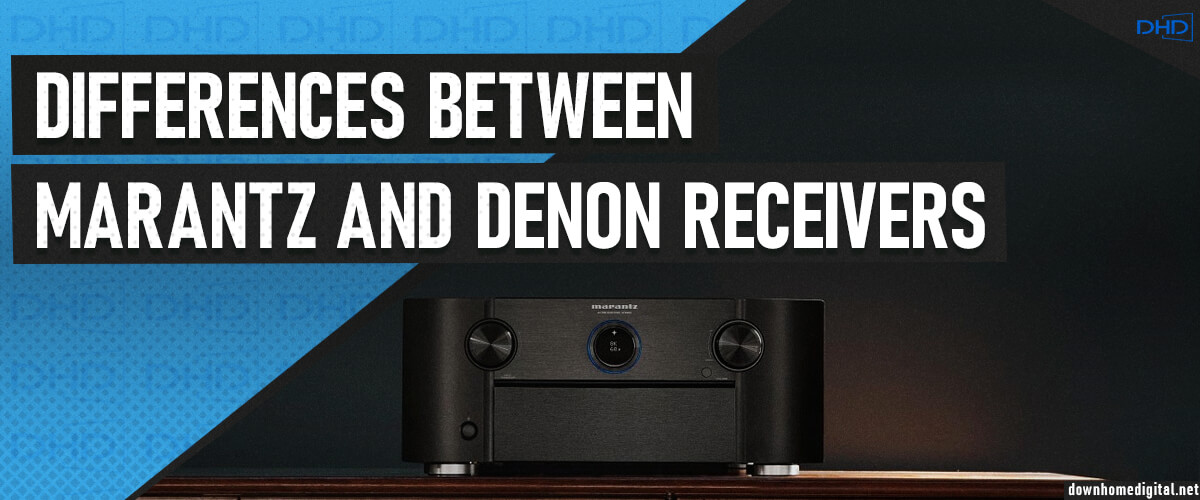
Home theater receivers are becoming more efficient and better equipped. However, the development of new technologies is rare. Therefore, there are strong similarities between products and even between brands. And it’s getting harder and harder to choose Marantz or Denon.
However, there are still differences even between such closely related brands as Denon and Marantz. Denon receivers have a warm sound with pronounced effects, while Marantz receivers play softer. This also applies to each receiver separately. The bass from the Denon is more dynamic and powerful than the balanced bass from the Marantz. Highs also feel different. Denon has it brightly. Marantz has it with little detail.
And as you can see, Marantz receivers are more focused on working with music systems. In contrast, Denon receivers are more concentrated on home theaters, where it is essential to accentuate every effect and deliver a more immersive experience.
How I tested receivers by Marantz and Denon
I approach testing receivers in a comprehensive manner – I compare receivers in the musical capabilities and the capabilities of the receiver as a home theater system.
For the surround sound appraisal, I chose Mad Max: Fury Road. However, to assess the musical capabilities, I picked up a whole list of compositions.
- Queen – Bohemian Rhapsody – Deezer
- Radiohead – The National Anthem – Spotify
- Arctic Monkeys – Do I Wanna Know – SoundCloud
- The Weeknd – The Hills (CD player)
- Radiohead – The National Anthem(CD player)
- Mahler – Symphony No.2 (CD player)
- James Brown – Living In America (CD player)
- Daft Punk – Get Lucky (CD player)
For all av receiver comparisons stages, I selected the following equipment:
- CD player SACD 30n
- Blu-ray player Sony UBP-X700
- Speaker wire – AudioQuest Type-9
- Speakers for movie – Klipsch RP-8060FA
- Floorstanding Speakers – Bowers & Wilkins 703 S2
- Stereo speakers:
- Klipsch RP-8060FA
- KEF Q350
- DALI OBERON 5
Mid-price Marantz and Denon receivers comparison
Marantz CINEMA 60 vs Denon AVR-X3800H

In this review, you can see how Denon and Marantz offer completely different functionality for the same price (well, almost). Because the first pair consists of the 7.2-channel Marantz CINEMA 60 and the 9.4-channel Denon AVR-X3800H, using this pair as an example, I will explain to you the most striking difference that will always make you pay more for the Marantz name even though you get less (or the same but more expensive, I mean). Next, however, I will compare pairs with the same number of channels.
Looks never occupy me so much that I prefer one model over another because it neglects technical data. But agree, it’s always nicer to have a thing you like. Marantz has succeeded in this sense; its CINEMA lineup looks luxurious, and even to the touch, you realize you are dealing with a mid-priced segment. On the other hand, Denon has completely forgotten what design is, and all its models, from budget to high-end, look almost identical, old-school style. Nevertheless, the AVR-X3800H’s LCD is more viewable and informative, while the CINEMA 60’s is original (round) but completely useless (you can’t see anything on it).

But here we come to the main point. Why do you always overpay for a Marantz, even though the models are similar or even (often) Denon is superior in functionality? It’s all about what’s under the hood. Marantz occupies an elite niche not only for the quality of construction, which is undoubtedly very reliable but for the unique technologies developed by the company. Almost all brand receivers are equipped with them (except for the most budget ones), and they significantly affect the quality of the sound signal, providing the same excellent level after years of use (most receivers lose this quality over time). We’re talking about Current Feedback Topology (which provides wideband and high-speed playback) and Hyper Dynamic Amplifier Module (or HDAM – proprietary discrete PCBs to replace standard chips). I advise you to read more about these exclusive developments to understand how they work. And if very briefly and clearly, imagine that you have a Mercedes (Marantz) and, say, a Volkswagen (Denon) in front of you. Nothing to pick on the latter for, but you get what I mean.
The first obvious difference is the number of channels I’ve already mentioned. But AVR-X3800H went even further and provided processing of 11 channels (with an additional amplifier), which took the model far away from CINEMA 60. Accordingly, the maximum configuration of Marantz is 5.2.2, and Denon’s is 7.2.4 or 5.4.4, as you prefer. Thus, AVR-X3800H surpasses CINEMA 60 in its ability to decode surround sound formats and has Auro 3D and IMAX Enhanced in its arsenal. Their power output is also identical, but 105 watts (8 ohms, 20 Hz – 20 kHz, 0.08%, 2ch) for 11 channels of Denon is a bit low, in my opinion, while 100 watts of Marantz in a small room will make your walls shake.
Given the 2022 models’ release, their video output is state-of-the-art, and they both support 8K resolution, including all the accompanying HDMI 2.1 features. But the difference is the number of ports with this functionality, of which the Marantz has 3, and the Denon has 6 pieces.
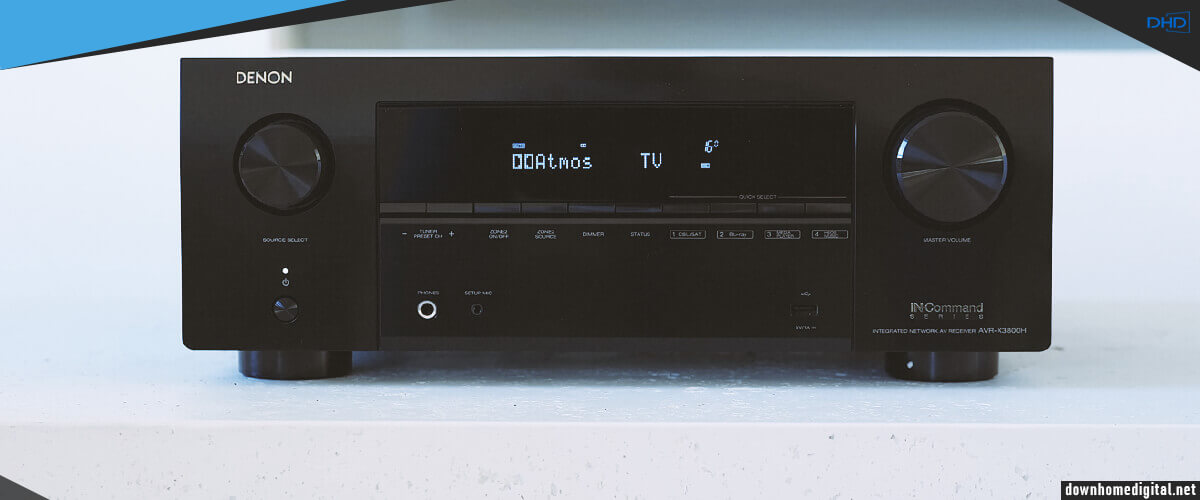
If you’re not an audio expert, you won’t notice any difference in the systems’ sound, as both provide clean, warm sound with lots of detail and excellent dispersion. It makes perfect sense that the AVR-X3800H has a richer soundstage; add to that 4 subs. But only because when there are more channels, the sound words are more accurately distributed. I tested the receivers in different studios because the 7-channel AVR is designed for a room of about 300 square feet, while the 11 channels are for a much larger space. And so it’s safe to say that with the same movie (Avatar: Path of Water), the AVR-X3800H and the CINEMA 60 performed admirably. However, the Marantz has a deeper sound, and the Denon’s sound is always brighter. I guess it’s a matter of taste, and the instruments showed that whichever you choose will be right.
I liked the stereo better with the AVR-X3800H. When using HEOS (both have it), the CINEMA 60 sounds a bit flat compared to the Denon (there’s a reason it says CINEMA in its name – it’s made for movies). But in terms of functionality and wireless capabilities, I’m sure they’ll suit any level of music lover, including vinyl lovers (there are phono inputs, and both receivers are great with analog sound, though Marantz is always a bit warmer, more authentic than the brash Denon).
The Denon vs Marantz receivers rivalry has a long history. Not so long ago, the companies merged into an alliance, but they have retained their uniqueness in technology development and recognizable sound. If the choice depended on my opinion, I would prefer the Denon AVR-X3800H in this pairing because, for the same money, you get more channels (9.4 and 11.4 processing vs. 7.2), more HDMI ports with 8K video processing, Auro 3D and IMAX Enhanced.
If you’re the kind of person who wants to pass on great equipment to your grandchildren, who understands the quality of internal components in preference to their modern features, then the Marantz CINEMA 60 is for you, which is simply designed for watching movies in a not too big room, creating a powerful stream of sound that reaches every corner of the room and every pore on your body. Nevertheless, the AVR-X3800H knows its job, and if you add 4 subs to it as the manufacturer intended, you can also get a powerful system. The choice is yours, and I’ve made my case.
| Marantz CINEMA 60 | Denon AVR X-3800H | |
| Channels | 7.2 | 9.4 |
| Power output | 100W/8 Ohm, 140W/6 Ohm | 105W/8 Ohm, 135W/6 Ohm |
| HDMI inputs/outputs | 6/2 (8K/60Hz and 4K/120Hz pass-through) | 6/3 (8K/60Hz and 4K/120Hz pass-through) |
| Bluetooth/Wi-Fi | yes/yes | yes/yes |
| Video functions | video conversion analog to HDMI, analog to HDMI scaling, HDMI to HDMI scaling | video conversion analog to HDMI, analog to HDMI scaling, HDMI to HDMI scaling |
| Supports | HDMI ARC, HDMI eARC, HDMI CEC, HDCP2.3, HDR10, HDR10+, Dolby Vision | HDMI ARC, HDMI eARC, HDMI CEC, HDCP2.3, HDR10, HDR10+, Dolby Vision |
| Streaming services | AirPlay2, Spotify, Pandora | AirPlay2, Spotify, Pandora |
| Surround sound | DTS:X, Dolby Atmos | DTS:X, Dolby Atmos |
Marantz CINEMA 60 pros & cons
Pros
- Exclusive sound processing technology.
- It will work as well as the first day, even after many years.
- It has 100 watts of power for 7 channels, making your walls shake (in a small room).
Cons
- Inferior to the Denon AVR-X3800H in the number of channels and handling of surround sound formats.
- Has 3 (vs. 6) HDMI ports with 8K support.
Denon AVR-X3800H pros & cons
Pros
- More channels (9.4 and 11.4 processing)ю
- Support for Auro 3D and IMAX Enhanced.
- More 8K HDMI ports.
Cons
- Not as advanced internals as the Marantz.
Marantz CINEMA 50 vs Denon X-4800H
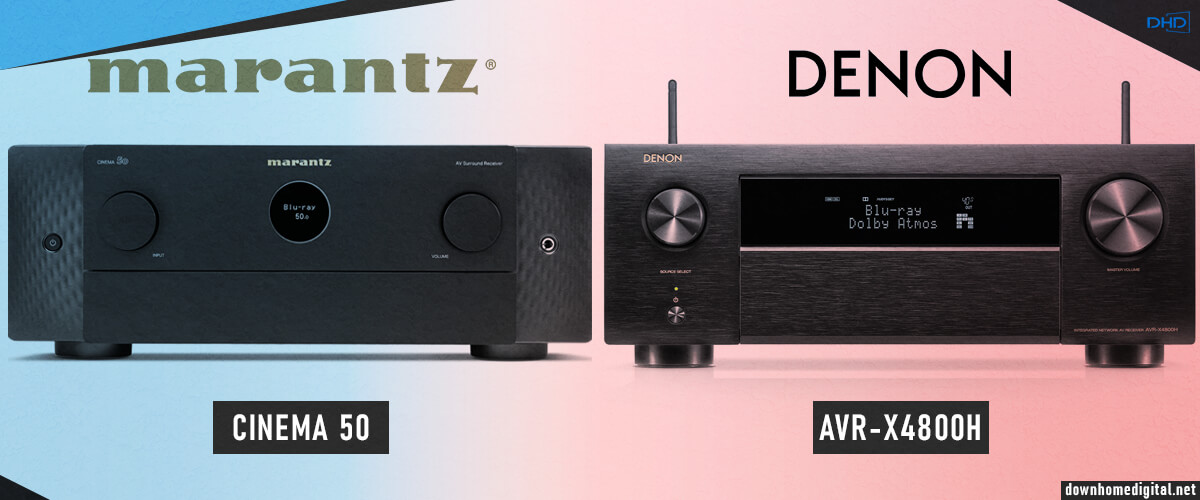
Next on the test, I have a pair of Denon AVR-X4800H vs Marantz CINEMA 50. Again, both manufacturers have done an excellent job on the audio component of the receivers – supporting 9.4 channels of amplification and 11.4 processing (with an external amplifier). Power output varies, being 110 watts (Marantz) versus 125 watts (Denon) for 8 ohms (20 Hz – 20 kHz, 2ch Drive). The AVR-X4800H has a THD of 0.05%, while the Marantz has 0.08%. So, from the threshold, we can see that Denon did a better job; it affected the sound picture, but let’s not forget about Marantz’s internal components. In 10 years, it will still sound like it does today, which is not the case with Denon (but it is also a long-lived AVR).
Here, we can pay a little more attention to the design details. Marantz’s SINEMA line looks unusual. You can recognize it by its unusual sides and round LCD, on which, as I’ve already mentioned, you can’t see anything at a distance of several steps (my eyesight is fine if anything). The cover on the front panel is removable, and that’s handy when you spend a lot of time with customization. But the buttons are small and awkward to press on the recessed panel. The AVR-X4800H has a more classic design but also has rather awkward buttons. To me, with my large fingers, they seemed just a mockery. Otherwise, the receivers are excellent: the heavyweight (29.1 and 29.8 pounds) provides stability, and the housings are pleasant to the touch (the naked eye can see the high class). Even the on-screen menus are well thought out and will be easy even for a beginner, despite the system’s complexity (you will have to spend time).
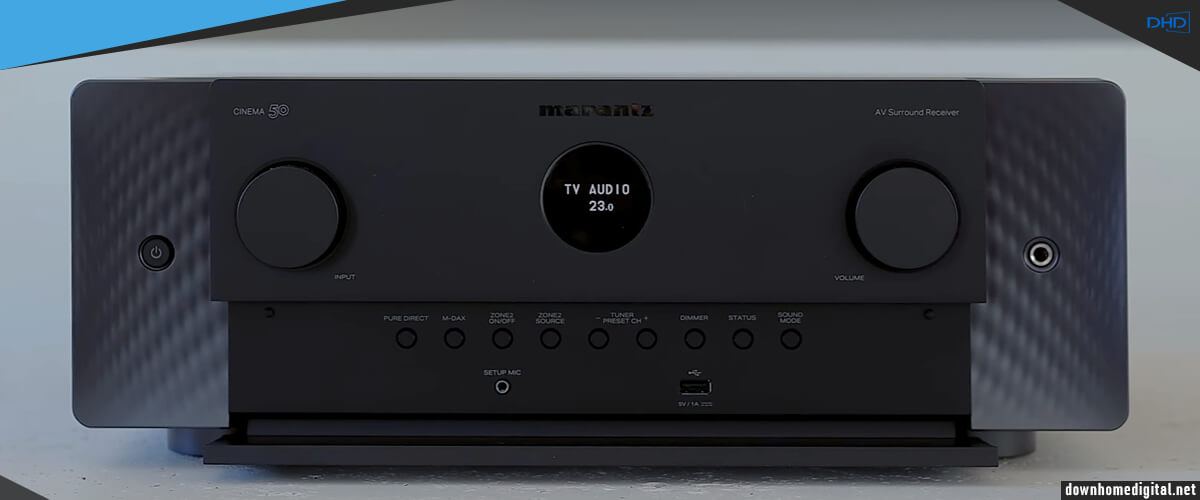
The video output is also similar: 8K 60Hz support on all HDMI ports (receivers released in 2022). Only the AVR-X4800H has 7 of them, while the CINEMA 50 has only 6. Everything else is identical, including the remarkable upscaling to 8K, virtually indistinguishable from the original. The receivers support all existing HDR formats and full gamer functionality, confirming their mid-priced (close to premium) segment status. But if you’re a fan of old tech, the Marantz doesn’t have component and composite jacks.
And it turns out that the receivers are very similar, but I’ll tell you, don’t rush to think so. To compare Marantz and Denon sound quality, everything falls into place – the AVR-X4800H sounds powerful and restrained, flexible, but not without bright details. However, Marantz showed the opposite results, but still a good sound performance. The CINEMA 50 had a pretty thin bass, but the songs sounded very clean and detailed. At the same time, the AVR-X4800H lacks bass in its pure form (without subs).
When watching a movie with AVR-X4800H in 5.4.4 mode, I was surrounded by spatial and realistic sound, so I felt right in the film. Each effect just burst into the room with powerful, rich bass. And any object I could track thanks to the precise positioning of objects in Dolby Atmos perfectly.
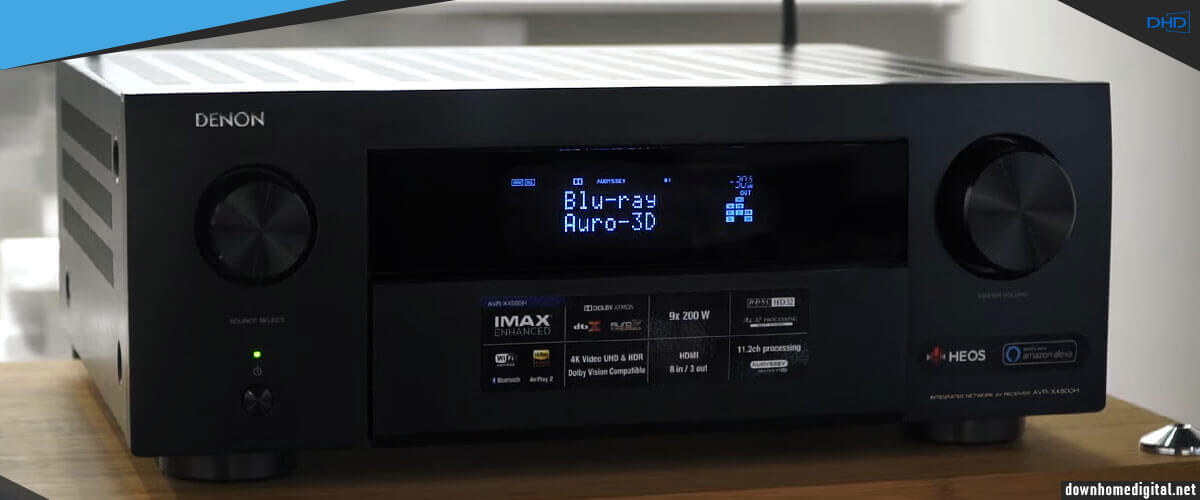
With the same configuration and movie (Iron Man), Marantz also shows impressive results. Effects sounded tangible and three-dimensional. The space was perceived as whole and realistic, without a single desynchronization. Clearly and precisely, hitting the points in space exactly as the author intended. In the first frames, when the missile hits the military auto, the sand may seem to fly right into your face. But the soundstage is smoother than that of AVR-X4800H. However, without special equipment, you’re unlikely to notice the difference.
The effect is identical in stereo, and the signal transfer is impressive. But thanks to MDAX2 technology, CINEMA 50 handles compressed audio better, allowing you to hear the track almost in its original form.
These two very similar devices are aimed at a mass audience, and their functionality will be enough for 99% of users(they support almost all modern surround sound and 8K video options on all HDMI ports). This is a great investment if you want a top-of-the-line device in this price range. And your choice will depend on your personal preferences.
The Denon AVR-X4800H has more power, cleaner THD, and more HDMI ports. The Marantz CINEMA 50 has a more realistic soundstage, but you can connect legacy devices in less than the AVR-X4800H. At the same time, the Marantz handles stereo better, becoming a versatile device. Although, honestly, without instruments and special education, you are unlikely actually to feel the difference. Still, it is worth remembering that Marantz can have a longer service life with equal initial functions and cost.
| Marantz CINEMA 50 | Denon AVR X-4800H | |
| Channels | 9.4 | 9.4 |
| Power output | 110W/8 Ohm, 150W/6 Ohm | 125W/8 Ohm, 165W/6 Ohm |
| HDMI inputs/outputs | 6/3 (8K/60Hz and 4K/120Hz pass-through) | 7/3 (8K/60Hz and 4K/120Hz pass-through) |
| Bluetooth/Wi-Fi | yes/yes | yes/yes |
| Video functions | video conversion analog to HDMI, analog to HDMI scaling, HDMI to HDMI scaling | video conversion analog to HDMI, analog to HDMI scaling, HDMI to HDMI scaling |
| Supports | HDMI ARC, HDMI eARC, HDMI CEC, HDCP2.3, HDR10, HDR10+, Dolby Vision | HDMI ARC, HDMI eARC, HDMI CEC, HDCP2.3, HDR10, HDR10+, Dolby Vision |
| Streaming services | AirPlay2, Spotify, Pandora | AirPlay2, Spotify, Pandora |
| Surround sound | DTS:X, Dolby Atmos | DTS:X, Dolby Atmos |
Denon AVR-X4800H pros & cons
Pros
- Very low THD of 0.05% (vs. 0.08% of Marantz).
- More power (125W vs. 110W).
- More HDMI ports (7 vs. 6).
Cons
- Not enough bass in its purest form.
Marantz CINEMA 50 pros & cons
Pros
- Pros and cons of the Marantz CINEMA 50.
- Deeper soundstage in movies.
- Handles compressed audio better thanks to MDAX2 technology.
Cons
- No component and composite connectors.
Premium Marantz and Denon receivers comparison
Marantz SR8015 vs Denon AVR-X6700H
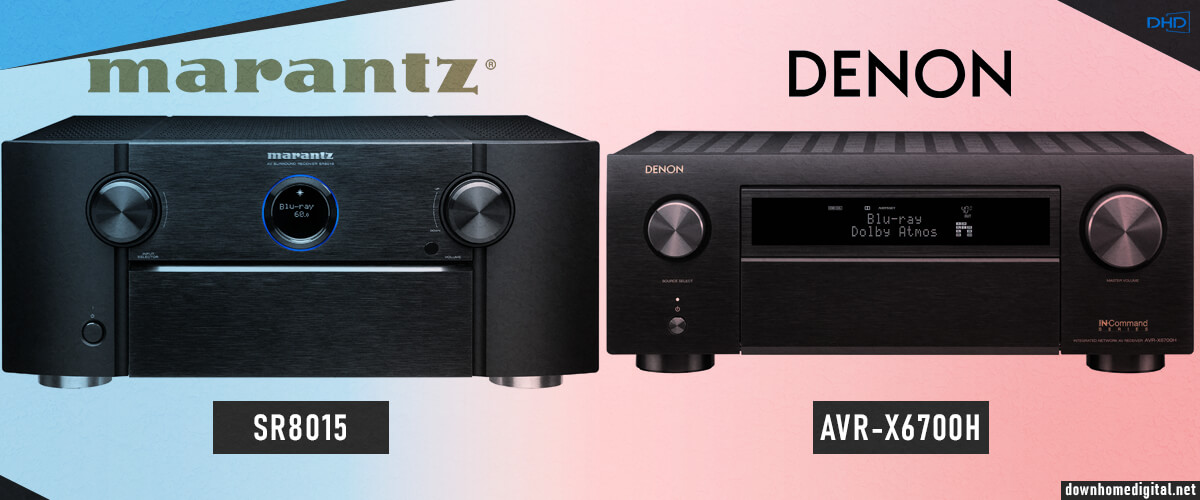
It’s time for the Marantz versus Denon premium devices comparison. Right away, I will note that there is no fundamental difference between these models. Both were released in 2020, and brands already prepared replacements for both. But these 11.2-channel receivers, expandable up to 13 channels and with identical power of 140 W (8 ohms, 20 Hz – 20 kHz, 0.05%, 2ch) are excellent representatives of the high-end level, for which today the price is reduced relative to the original. Go ahead. This is your chance to get something extraordinary at a reasonable cost.
What can I say about the construction of premium receivers? They are timeless solid metal housings weighing 33 (Denon) and 38 (Marantz) pounds. It is pertinent to say here that weight says a lot about the receiver’s quality. Using expensive internal components always makes the unit imposing in size (all components must be spaced far enough apart not to create electronic interference) and have good ventilation. Both models have manual controls hidden under metal covers. What I don’t like about Marantz is the small round LCD (as in the SINEMA series), but in this case, there is a full-fledged monitor hidden under the cover, where you can see everything.
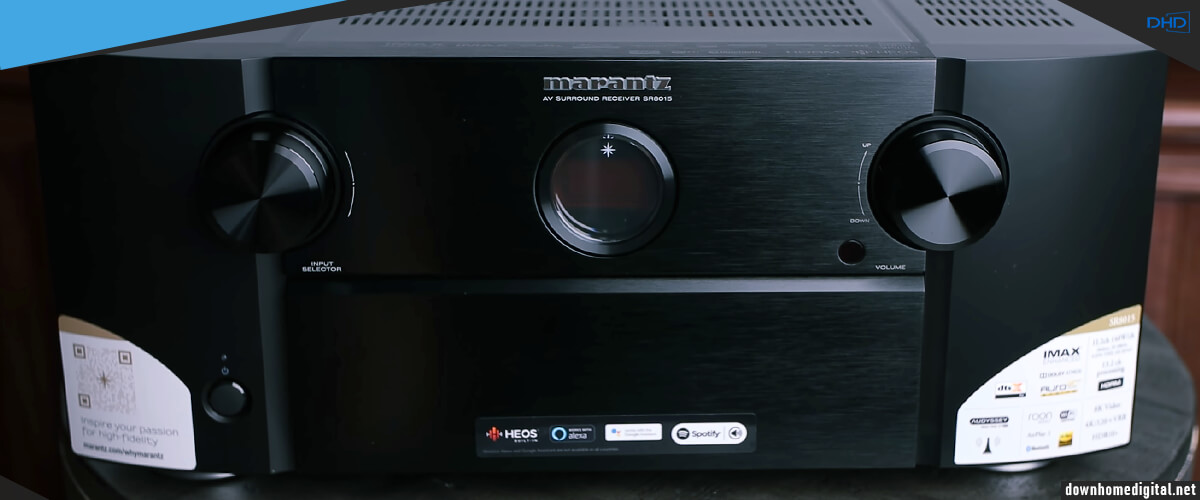
The crown jewel of the AVR-X6700H is the video path, which is fully 8K compatible. This support includes support for 8K / 60Hz and 4K / 120Hz. All relevant HDR formats are supported, of course, including HDR10 +, HLG, and Dolby Vision. A similar situation is with the competing Marantz SR8015. But since we’re talking about fairly long-lived models, 8K is only available on 1 HDMI port on both.
At the beginning of the test, the 6700H showed me an excellent reproduction of the film’s entire soundscape. The dialogues in the foreground were displayed clearly and in detail, as were the voices in the background. Thus, the AVR-X6700H can accurately differentiate parallel acoustic events on the one hand while at the same time producing a uniform overall sound image.
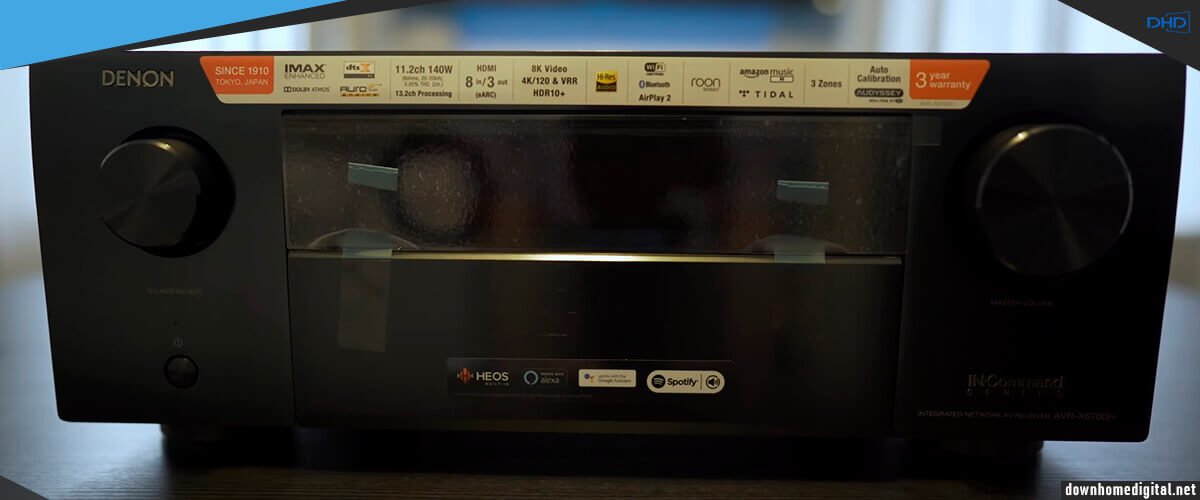
The Marantz SR8015 also showed excellent dynamics when watching a movie. It delivered faithfully effects, exactly where they should be. Background music is played tightly, powerfully, and clearly in the high-frequency range. This balanced receiver presents voices quite clearly. However, I can say that the low frequencies do not have enough power.
In terms of music processing, the SR8015 does a little better. It reproduces songs, incredibly dense and multifaceted. The same cannot be said for Denon. The overall reproduction quality remains relatively high, but there is a lack of frequency differentiation. But I was incredibly impressed with how well the AV amplifier worked its voices.
The test showed that the Denon AVR-X6700H is focused on surround sound and home theater. Equipped with the latest technology will please home theater owners for many years. At the same time, the year of release has left its mark, and I found the Heos module incompatible with MQA. The remote control is outdated, but the setup itself did not cause difficulties, thanks to the setup wizard.
The Marantz SR8015 is designed for true audiophiles and does an excellent job of playing even the highest-quality tracks. Although for the unsophisticated user, movies with it will sound great. The system is simple to set up. Audyssey MultEQ XT32 perfectly copes with averaged settings, which will suit most listeners (this also applies to AVR-X6700H).
In addition to what has been described, the receivers have one major drawback that unites them because of their year of release (2020). They have only 1 HDMI port each, supporting 8K video. But since I consider this feature exaggerated (there is still little content with this resolution today), it allows me to consider the receivers relevant, especially when you consider that both premium models are selling for less today than their original cost.
| Marantz SR8015 | Denon AVR-X6700H | |
| Channels | 11.2 | 11.2 |
| Multichannel pre out | 13.2 | 11.2 |
| Power output | 140W/8 Ohm, 175W/6 Ohm | 140W/8 Ohm, 175W/6 Ohm |
| HDMI inputs/outputs | 8/3 (8K/60Hz and 4K/120Hz pass-through) | 8/3 (8K/60Hz and 4K/120Hz pass-through) |
| Bluetooth/Wi-Fi | yes/yes | yes/yes |
| Video functions | video conversion analog to HDMI, analog to HDMI scaling, HDMI to HDMI scaling | video conversion analog to HDMI, analog to HDMI scaling, HDMI to HDMI scaling |
| Supports | HDMI ARC, HDMI eARC, HDMI CEC, HDCP2.3, HDR10, HDR10+, Dolby Vision | HDMI ARC, HDMI eARC, HDMI CEC, HDCP2.3, HDR10, HDR10+, Dolby Vision |
| Streaming services | AirPlay2, Spotify, Pandora | AirPlay2, Spotify, Pandora |
| Surround sound | DTS:X, Dolby Atmos | DTS:X, Dolby Atmos |
Marantz SR8015 pros & cons
Pros
- Managed channels can be configured flexibly.
- Easy to set up the system.
Cons
- Only one HDMI 2.1 port (like the Denon AVR-X6700H).
Denon AVR-X6700H pros & cons
Pros
- Immersive, spatially dense sound.
- Easy commissioning thanks to the setup wizard.
Cons
- The Heos module is incompatible with MQA.
- Outdated remote control.
Budget Marantz and Denon receivers comparison
Marantz NR1510 vs Denon AVR-S670H
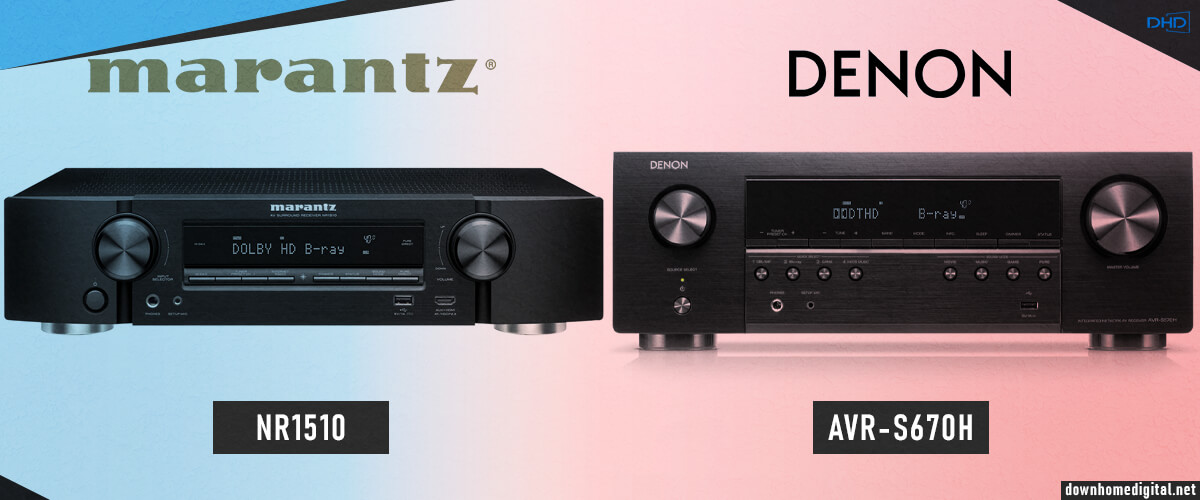
Next, let’s compare 5.1 channel receivers – Denon AVR-S670H vs Marantz NR1510. The Denon AVR-S670H is the model with a power of 75 W/8 Ohm or 100 W/6 Ohm and dual subwoofer outputs, outperforming the competitor in this comparison with its 50 W/8 Ohm, 60 W/6 Ohm output.
The Marantz NR1510 is a narrow-profile receiver. This is what explains the difference in power. It is very convenient, but you should know that such models are prone to overheating (because the internal components are located too close to each other). Nevertheless, push-button control is the one I like most. At the same time, the Denon AVR-S670H has more pliable source selection and volume controls.
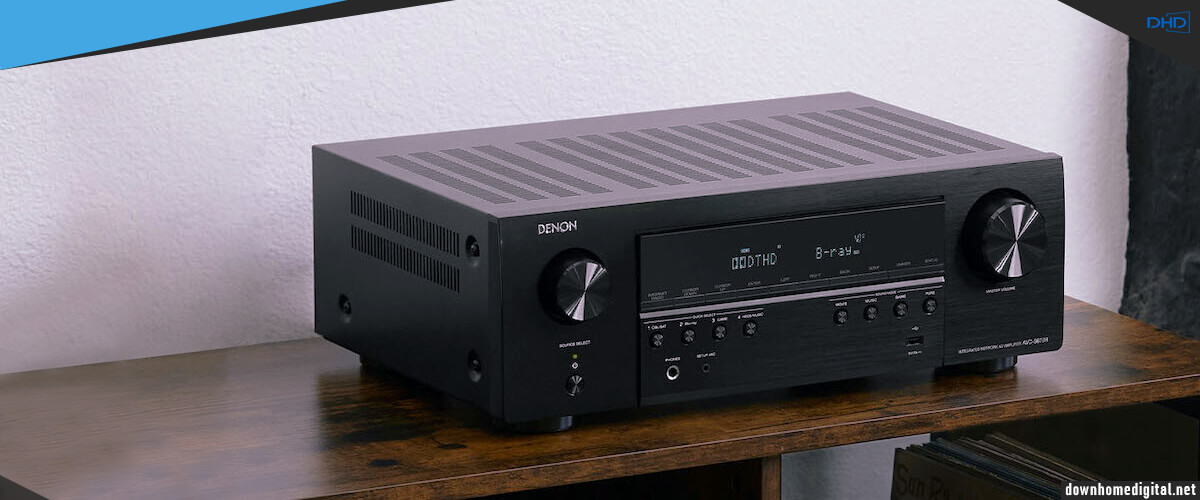
In addition, the AVR-S670H has 6 HDMI inputs and one output. 3 of which support 8K format and HDCP 2.3, but NR1510 has the same video path configuration but with HDCP 2.2 protection and processes video only with 4K/60Hz resolution. This difference is due to the year of release (Denon is 2023, but Marantz is 2019). Three pairs of analog and phono and two digital optical represented the rest of the audio inputs. In addition, there is an FM tuner, an Ethernet jack, and two antennas dedicated to Wi-Fi and Bluetooth.
We would also like to note that among these two models, the Marantz NR1510 is compatible with the only DTS HD Master surround sound format. In contrast, the AVR-S670H supports DTS HD Master, DTS Neo:6, Dolby TrueHD, and Dolby ProLogic Il. As you can see, “age matters.
Both receivers are equipped with a built-in HEOS system developed by Denon. But after the unification of the brands into an alliance, no Marantz is without it. The broadcast showed a high level of stable signal retention. Given the minimum configuration for surround sound, such a bonus is nice for users looking for a versatile system.
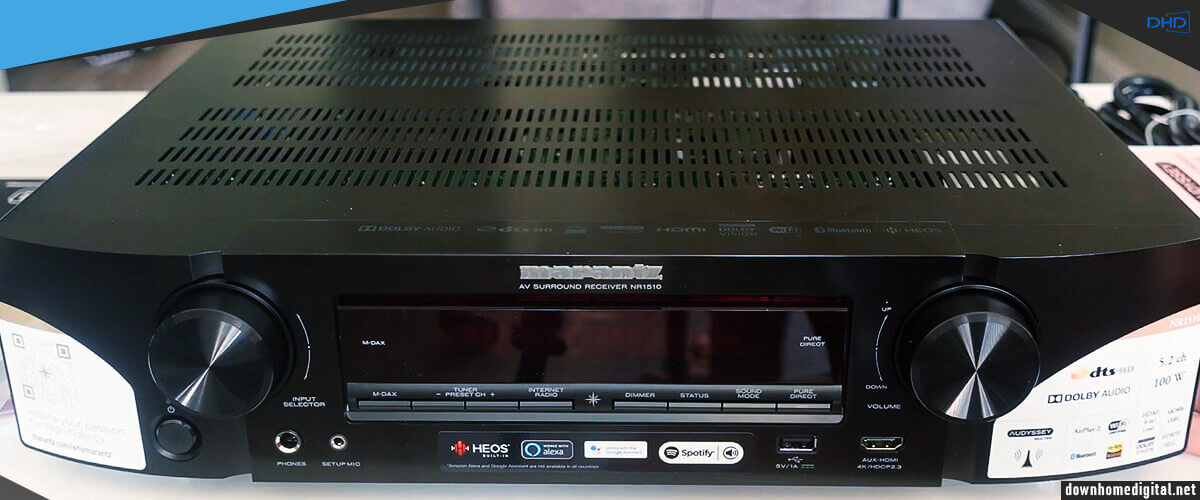
During the test, it became clear to me that the AVR-S670H has a more responsive bass. The receiver gives them incredible depth. In addition, Denon’s quality efforts in selecting converters directly affect the clarity of the sound image and especially the stereo space.
Marantz is also keeping up with its competitor, and I have heard a good level of detail and emphasis on high-/mid-frequencies. The sound is warm and very similar to that of stereo amplifiers but remains limited in power.
In terms of surround sound, the Marantz NR1510 doesn’t outperforms the Denon AVR-S670H. I would even point out that it lacks the momentum of the last one. The sound effects in both cases moved clearly from one speaker to the other. And I also want to point out the accuracy of the level of detail, which gives the impression of being sonically immersed in the movie.
And since we were comparing two slightly different receivers, I can safely say that the Marantz NR1510 is ideal for creating an entry-level home theater system. The Denon AVR-S650H, on the other hand, is more suited for creating a home audio system, as it handles music from any source well, providing high-level dynamics suitable for any genre.
However, the Denon AVR-S670H is newly released relative to the time of writing this review and, therefore, is a more modern device (it supports 8K video on 3 HDMI inputs, whereas the NR1510 only handles 4K/60Hz resolution). Moreover, it decodes more surround sound formats. But the Marantz works with the highest quality DTS HD Master, so that’s enough for any movie. Plus, the NR1510 has a narrow profile, which makes it comfortable for small systems and narrow cabinets (portable).
| Marantz NR1510 | Denon AVR-S670H | |
| Channels | 5.2 | 5.2 |
| Power output | 50W/8 Ohm, 60W/6 Ohm | 75W/8 Ohm, 100W/6 Ohm |
| HDMI inputs/outputs | 6/1 (4K/60Hz pass-through) | 6/1 (4K/60Hz pass-through) |
| Bluetooth/Wi-Fi | yes/yes | yes/yes |
| Video functions | 4K/60Hz pass-through in standby mode | 4K/60Hz pass-through in standby mode |
| Multi-room zones | no | 2 |
| Supports | HDMI ARC, HDMI eARC, HDCP2.3, HDR10, Dolby Vision | HDMI ARC, HDMI eARC, HDCP2.2, HDR10, Dolby Vision |
| Streaming services | AirPlay2, Spotify, Pandora | AirPlay2, Spotify, Pandora |
| Surround sound | DTS HD Master, Dolby TrueHD | DTS HD Master, Dolby TrueHD |
Denon AVR-S670H pros & cons
Pros
- Dynamic, expansive, and accurate stereophonic space.
- More powerful (75 watts per channel).
- Supports 8K video.
Cons
- Slightly inferior to NR1510 in surround sound.
Marantz NR1510 pros & cons
Pros
- Detailed and warm home theater sound.
- Comfortable narrow profile.
Cons
- Very low power handling at 50 watts.
- Supports 4K video only.
Stereo Marantz and Denon receivers comparison
Marantz NR1200 vs Denon DRA-800H
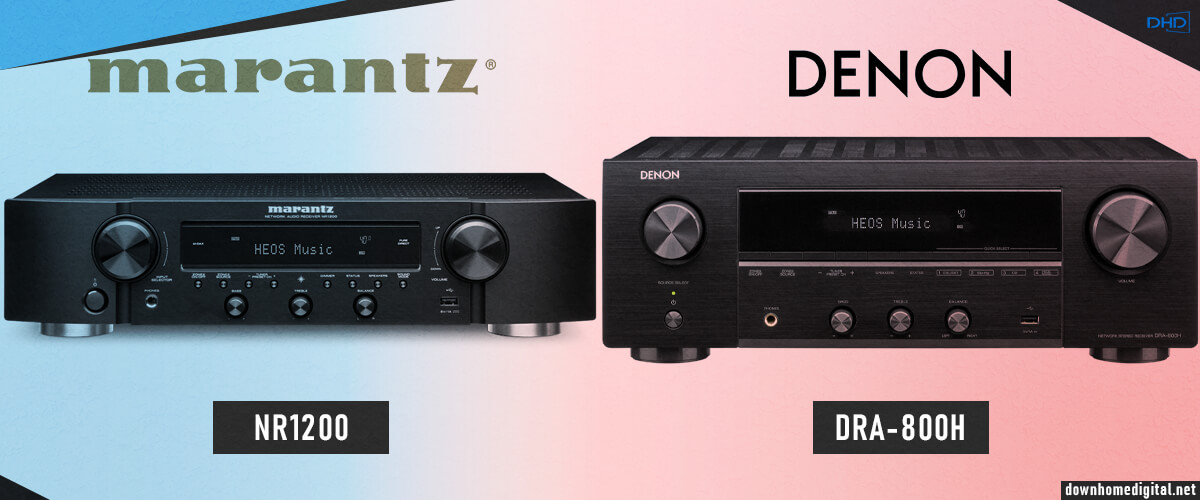
Finally, a comparison of Marantz NR1200 vs Denon DRA-800H. In terms of their configuration, they differ little. This mainly affects the Denon vs Marantz amplifying unit. The Marantz NR1200 delivers 75 W/8 Ohm per channel, while the Denon DRA-800H delivers 100 W/8 Ohm.
As with the 5-channel receivers in this pair, the Marantz NR1200 has a slim-profile chassis that makes it convenient for compact or portable systems. But this also accounts for the lower power output. Both stereo receivers have manual equalization via rotary controls, and I like Denon’s operation better. Its controls are more responsive in the hand, and I was able to fine-tune the sound more quickly.
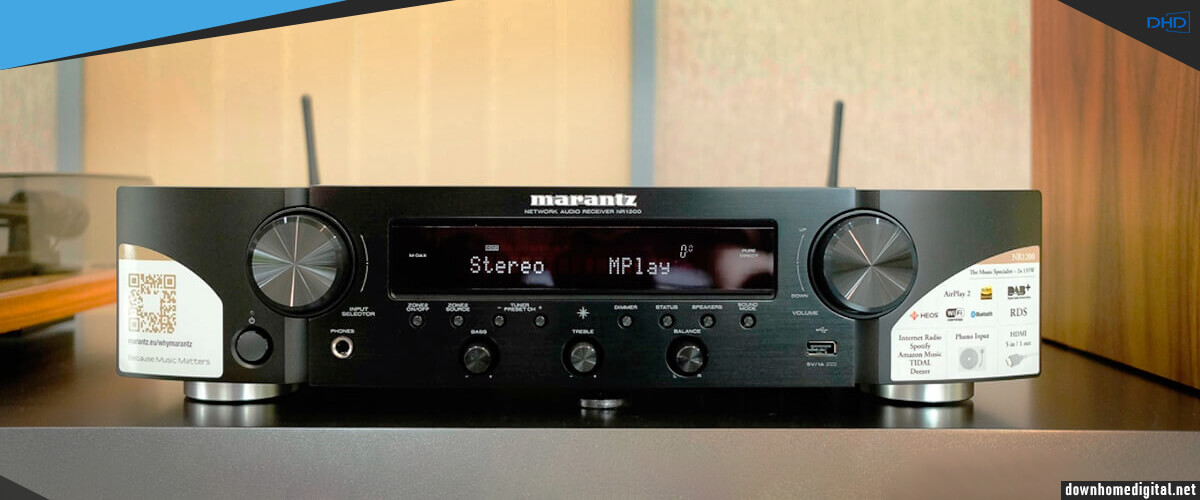
Immediately, I say that in terms of connectivity, the compared receivers are identical. Both receivers also incorporate all the connections to make it a true Hi-Fi stereo receiver. Thus, 4 RCA inputs, a phono input compatible with MM cartridges in Denon, and 6 RCA inputs in Marantz. But the most interesting thing is that both stereo receivers have 5/1 HDMI ports version 2.0 (works with 4K video). This essentially makes them hybrids with the possibility of integration into a home theater with stereo sound.
Moreover, each of the receivers has Wi-Fi, Bluetooth, HEOS, AirPlay 2, as well as the ability to control the receivers using voice assistants (Amazon Alexa, Google Assistant, Siri).
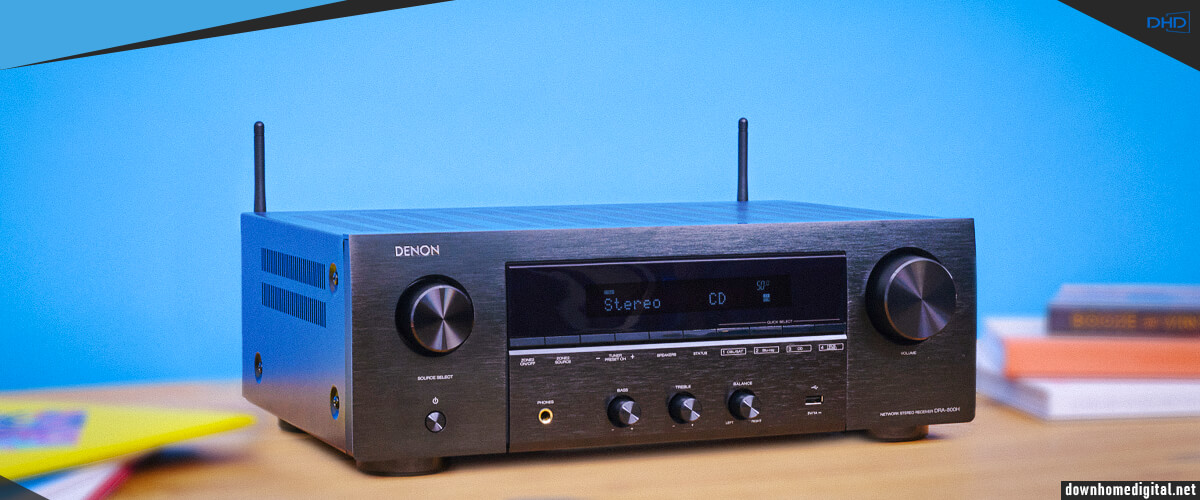
I noticed tangible differences when I started testing receivers. In the music test, the Marantz NR1200 was doing well with displaying each frequency register. In addition, the stage is wide and very dynamic. Finally, the vocals are natural. However, Denon plays in a completely different way. The sound is smooth. The bass hits hard. Despite the lack of an EQ mode designed to play the song, vocals stand out fairly easily from the background sound, but not quite as well as the competitor.
To summarize, I can say that these receivers are a starter solution for centralizing all audio and video sources in the living room. However, the Marantz NR1200 is a better choice if you are into music. Its sound seems more lively compared to the Denon. Nevertheless, this is an individual judgment. Besides, it depends on your capabilities, too (Denon is cheaper).
But in any case – both receivers improve your TV’s sound, allow you to broadcast 4K video, and have quite extensive wireless functions, which is extremely suitable for modern music lovers. They both stand out from the crowd of similar stereo receivers in other brands.
| Marantz NR1200 | Denon DRA-800H | |
| Channels | 2.0 | 2.0 |
| Power output | 75W/8 Ohm | 100W/8 Ohm |
| HDMI inputs/outputs | 5/1 | 0/0 |
| Phono Input | yes | yes |
| Bluetooth/Wi-Fi | yes/yes | yes/yes |
| Streaming services | AirPlay2, Spotify, Pandora | AirPlay2, Spotify, Pandora |
Marantz NR1200 pros & cons
Pros
- Compact body.
- Easy to customize.
Cons
- Less power.
Denon DRA-800 pros & cons
Pros
- Precise bass in movies.
- Connectivity Wi-Fi, Bluetooth, Airplay 2.
Cons
- Vocals highlighted not as good as Marantz’s.
Discontinued models
This is another example of a nice pair of AVRs that are now discontinued. This may interest some of you as the price is now reduced. Yes, they have been replaced by newer (and more expensive) receivers, but the models still hold their relevance.
Marantz SR6015 vs Denon AVR-X3700H
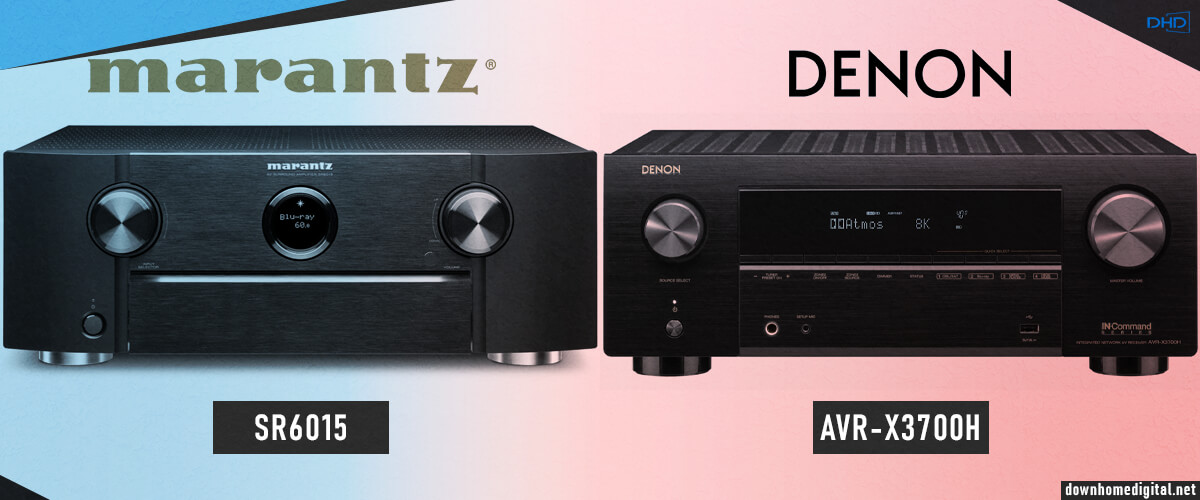
HDMI version 2.1 came out in 2021, and since then, even inexpensive models can handle 8K video. Two very similar models – Marantz S6015 and Denon AVR-X3700H have one flaw that made them obsolete against the newly released products. Only 1 HDMI port works with 8K. But otherwise, they are very good. This is the middle price segment, which is the most popular among users.
These two receivers are pretty similar in terms of audio processing. Both have nine power amplifiers and 11.2-processing. However, in terms of the power supplied to the channel, there are differences: 110W/8 Ohm and 150W/6 Ohm for the Marantz SR6015 versus the inferior characteristics of the Denon AVR-X3700H – 105W/8 Ohm, 135W/6 Ohm. I would not say these are great differences, so there is equality in terms of power.
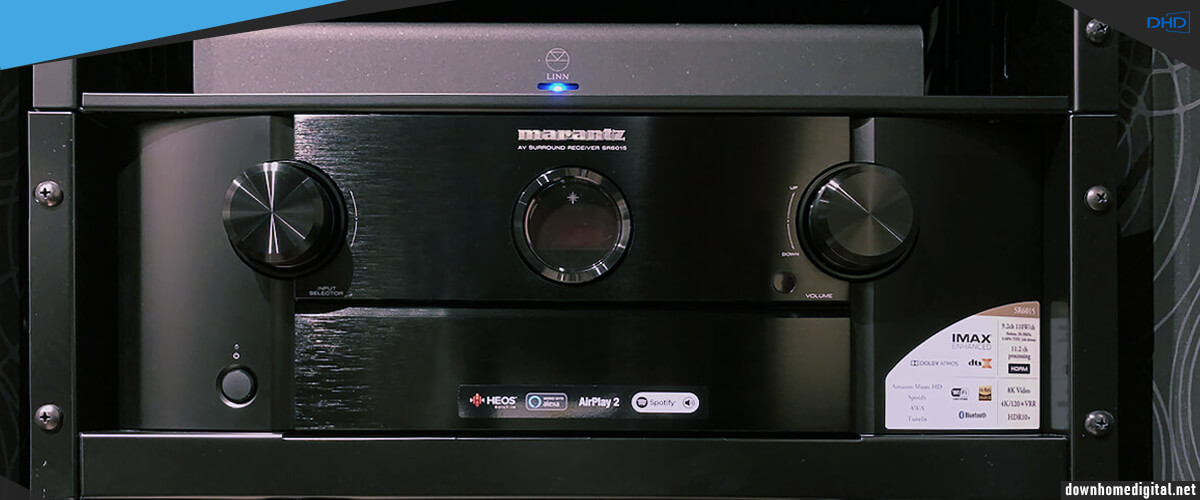
In terms of video capabilities, both receivers support 8K video for high-resolution content. According to the HDCP 2.1 protection, the new HDMI interface makes it possible to process 8K or optionally 4K with 120 frames per second. They also support the most critical HDR image formats with Dolby Vision. And here I find that the Marantz SR6015 has something to its competitor: an opportunity to upscale the analog video stream – 480i/576i up to 8K 60/50.
In the movie test, the Marantz SR6015 showed itself surprisingly well enough. I confidently can say that it combines fine signal processing and precise room measurement with sovereign power delivery. Marantz claims to offer its home theater receivers, especially musical sound, but here, it exceeded even my expectations. The SR6015 was at its high point when listening to music, but I didn’t expect anything different.
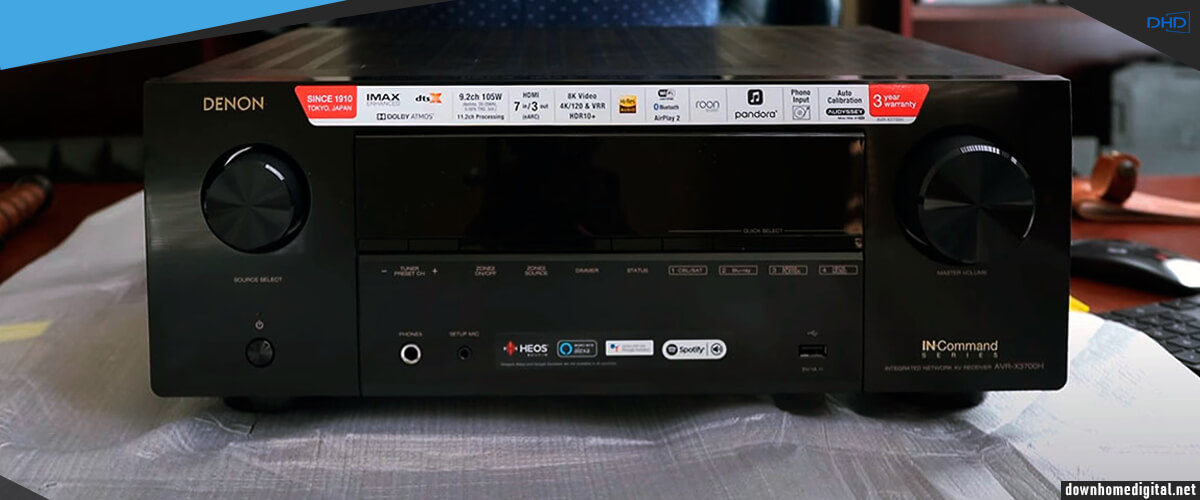
In contrast, the Denon AVR-X3700H has excellent video processing. The effects seem to patter directly from the ceiling and walls of the cinema room, and the noise of the motors pushes into the room. In addition, the dialogues are always clearly understandable and ideally located. It’s an awesome experience!
Both models have a full range of wireless technologies, such as Bluetooth, Wi-Fi, HEOS, and support streaming services.
Based on the testing results, I can conclude that the Marantz SR6015 and Denon AVR-X3700H are the top representatives of the medium price segment receivers. However, there is an explicit specialization of the devices. For example, Denon – home theater and surround effects, but when it comes to music, Marantz was a head-turner over its rival.
| Marantz SR6015 | Denon AVR-X3700H | |
| Channels | 9.2 | 9.2 |
| Power output | 110W/8 Ohm, 150W/6 Ohm | 105W/8 Ohm, 135W/6 Ohm |
| HDMI inputs/outputs | 7/3 (8K/60Hz and 4K/120Hz pass-through) | 7/3 (8K/60Hz and 4K/120Hz pass-through) |
| Bluetooth/Wi-Fi | yes/yes | yes/yes |
| Video functions | video conversion analog to HDMI, analog to HDMI scaling, HDMI to HDMI scaling | HDMI to HDMI scaling |
| Supports | HDMI ARC, HDMI eARC, HDMI CEC, HDCP2.3, HDR10, HDR10+, Dolby Vision | HDMI ARC, HDMI eARC, HDMI CEC, HDCP2.3, HDR10, HDR10+, Dolby Vision |
| Streaming services | AirPlay2, Spotify, Pandora | AirPlay2, Spotify, Pandora |
| Surround sound | DTS:X, Dolby Atmos | DTS:X, Dolby Atmos |
Marantz SR6015 pros & cons
Pros
- Auro 3D available.
- Powerful amplifier unit.
Cons
- The receiver gets very hot during operation.
Denon AVC-X3700H pros & cons
Pros
- Correct positioning of effects
- Deep and powerful bass
Cons
- Auro 3D is not available

